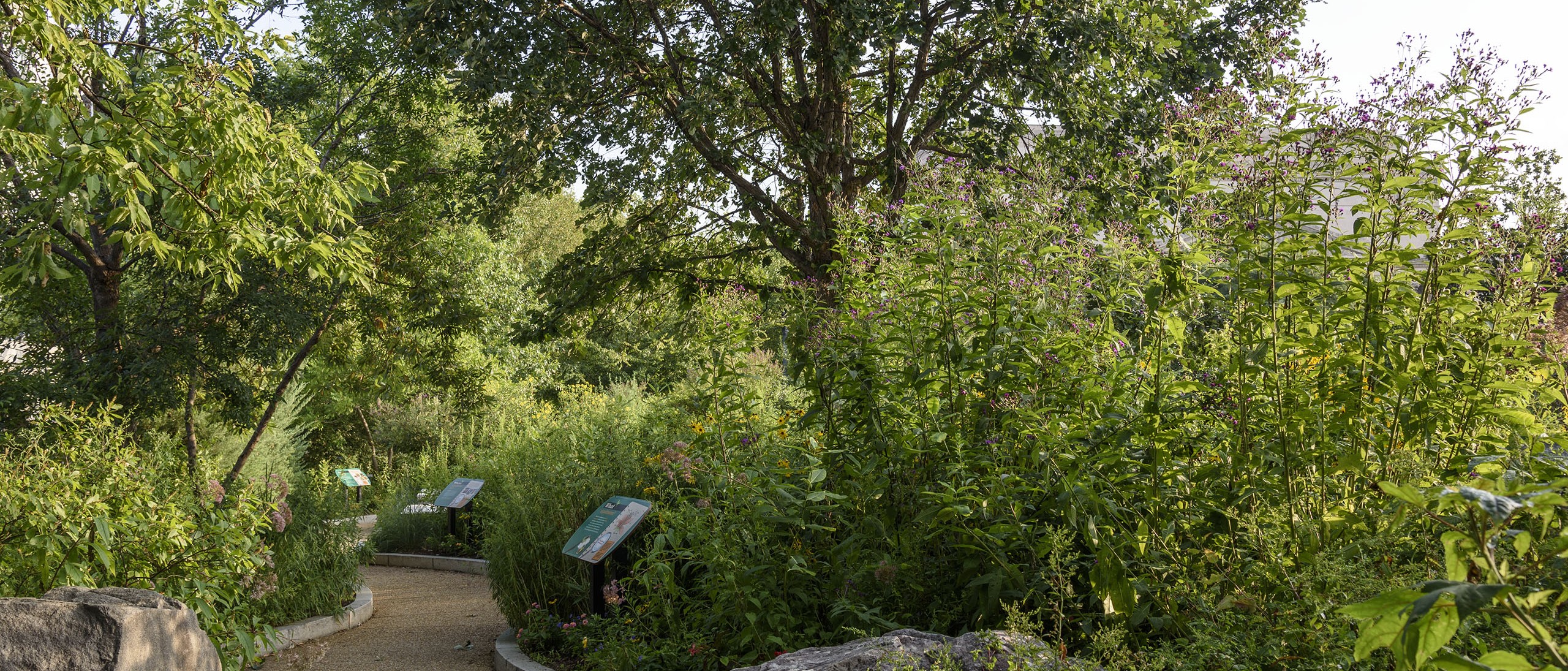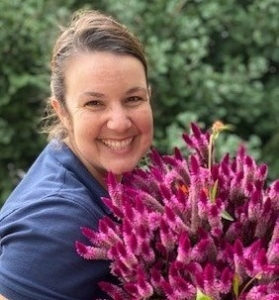
Made in the Shade: Creating Dynamic Shade Gardens

Too much shade to have a lush garden? Nonsense! Learn to love the shade you’ve got. Sylvia Schmeichel, Smithsonian Gardens Horticulturist, will share tips and tricks for creating layered and dynamic plant combinations that result in an inviting space.
Check out the Made In The Shade – Creating a Dynamic Layered Shade Garden Handout.
Webinar Video
Smithsonian Gardens’ Let’s Talk Gardens Series
Made in The Shade: Creating a Dynamic Layered Shade Garden
Presented by Sylvia Schmeichel, Lead Horticulturist, National Museum of Natural History
- Get to Know Your Site
- When does direct sunlight hit certain spots and for how long?
- What’s the soil condition?
- What’s the size of your space (length, width AND HEIGHT)?
- How do you want to use the space?
- Understanding Shade (Not All Shade is created equally)
- Full Sun – 6+ Hours direct sunlight (no shadows)
- i) Occurs in open fields/prairies/savannahs/ meadows.
- Part Shade/part-sun= 4-6 hours direct sunlight
- i) Occurs in woodland edges, forest clearings.
- Full Shade – less than 4 hours of direct sunlight
- i) Occurs under tree canopies, conifer forests.
- Seasonal shade
- i) Occurs under deciduous trees.
- Full Sun – 6+ Hours direct sunlight (no shadows)
- Sun intensity
- Morning and evening sun are less intense than mid-day or afternoon sun.
- Latitude matters, closer to the equator =more intense (Minnesota vs. Louisiana)
- Altitude matters, mountaintop = more intense
- Time of Day- some spots could have very intense sun for a few hours, then deep shade at other times.
- Soil and Drainage
- Conduct a soil test through your local county extension office (search: soil test extension *your state*)
- i) Will identify soil composition of sand/silt/clay
- ii) Water drains fastest in sand, slowest in heavy clay.
- Drainage can be impacted by several components.
- i) Shady areas dry more slowly and tend to hold moisture longer
- Dry (under trees, near other plants competing for space, under building overhands, near foundations)
- Average (holds some moisture, but drains steadily)
- Wet (may indicate high water table, high clay content, compacted soil)
- i) The presence of moss can be an indication of compaction/poor drainage.
- ii) If you did into your soil and it smells bad/rotten, it could be anaerobic.
- Conduct a soil test through your local county extension office (search: soil test extension *your state*)
- Taking Cues from Mother Nature
- In nature, shady conditions occur along woodland clearings and edges.
- Plant height is staggered and layered.
- There are seasonal successions of bloom time.
- Plants thrive in locations with suitable growing conditions.
- i) Look at the site conditions, then find a plant that will be happy there.
- Nothing is static, but always evolving.
- There are no hard and fast rules.
- Garden Composition
- Pro Tip: Successful shade garden designs tend to prioritize shape, form and texture before colorful blooms.
- Guiding the Eye:
- i) Texture:
- Rough holds the eye, appear closer to the viewer.
- Fine, generally dense, recede in the landscape, low impact background.
- ii) Shape:
- Overall plant shape (Growth habit)
- Repeating (continuity) vs. Contrasting (dynamic)
- i) Texture:
- Color: Flower AND Foliage
- Remember in Shade -dark colors appear darker, bright colors appear brighter.
- Monochromatic (similar color different shades)
- Analogous (neighbors on the color wheel ex. Yellow, orange, red)
- Complementary (Blue and orange/yellow)
- Dark colors recede to the background.
- Purple, maroon, black (creates backdrop to make other colors pop)
- Bright colors “pop”
- Yellow, orange, coral, white, lime
- Silver/ gray foliage they reflect light
- Seasonal Autumn colors (Fothergilla in the Fall is a showstopper!)
Don’t Forget Evergreens!
Rich Shillings’ Favorites for Shade:
- Trochodendron arailoides,
- Danae racemosa
- Cephalotaxus h. ‘ Prostrata’ ,‘ Gnome’
- Chamaecyparis obtusa’ Kosteri’, ‘Thoweil’ ,Nana Gracilis’
- Crytomeria japonica’ Cristata’, ‘Globosa Nana’, ‘Elegans Nana’, Tansu’
- Polystichum polybletharum
- Aucuba japonica ’Rozannie’
Arborist, Jake Hendee’s Favorite 12 Trees for Shade in the Mid-Atlantic
They “Dozen’t” need full sun!
- Acer rubrum, A. saccharum, A. griseum
- Fagus grandiflora (woody adelgid caution)
- Prunus virginiana
- Cornus sp.- C. alternifolia, C. florida, et al.
- Cercis canadensis
- Tsuga canadensis (woody adelgid caution)
- Hamamelis virginiana and H. vernalis
- 8 Ilex opaca (many cvs.)
- Amelanchier arborea, A. canadensis
- Chionanthus virginicus
- Magnolia virginiana, M. acuminata, M. macrophylla
- Carpinus caroliniana ‘Palisade’
Shade Tolerant Plant List
| Scientific Names | Common Names |
| Top Layer – Shrubs and Trees | |
| Lonicera nitida
|
Box or Wilson’s Honeysuckle *
(*not shown to be aggressive/invasive in Mid-Atlantic) |
| Hamamelis virginiana, H. vernalis, H. x intermedia | Witch Hazel and Winter Hazel |
| Cercis canadensis | Redbud (many cultivars) |
| Amelanchier laevis, A. arborea, A. canadensis | Serviceberry |
| Pieris japonica | Japanese Pieris or Andromeda |
| Cephalotaxus harringtonia | Plum Yew |
| Hydrangea quercifolia ‘Ruby Slippers’ (many cvs.) | Oakleaf Hydrangea |
| Hydrangea arborescens | Smooth Hydrangea |
| Viburnum opulus var. americanum
V. acerifolium, V. prunifolium V. dentatum |
Viburnums
Many tolerate full sun to part shade |
| Cornus florida, C. alternifolia, C. kousa | Dogwood |
| Asimina triloba | Pawpaw |
| Cephalanthus occidentalis | Buttonbush |
| Sarcococca hookeriana var. humilis | Sweetbox |
| Fothergilla gardenii, F. ‘Mt. Airy’, F. x intermedia ‘Blue Shadow’ | Fothergilla or Witch Alder |
| Clethra alnifolia many cvs. | Summersweet |
| Rhododendron sp. | Rhododendron |
| Kalmia sp. | Mountain Laurel |
| Leucothoe axilaris | Dog-Hobble |
| Vaccinium | Blueberry, Cranberry, Huckleberry |
| Azalea sp. | Azalea |
| Gordonia, Gordolinia | Gordonia, Gordolinia (Franklinia X Gordolinia) |
| Camellia japonica | Camellia |
| Sambucus canadensis, S.racemosa, S. nigra (cvs.) | Elderflower |
| Physocarpus opulifolius (cvs.) | Ninebark |
| *Aesculus parviflora | Bottlebrush Buckeye |
| *Itea virginica | Virginia sweetspire |
| *Lindera benzoin | Spicebush |
| *Calycanthus floridus | Carolina allspice |
| Philadelphus coronarius, P. pubescens | Philadelphus, Mockorange |
| *Symphoricarpos orbiculatus | Showy Coralberry |
| Aucuba japonica | Aucuba, Spotted Laurel |
| Deutzia gracillis ‘Chardonnay Pearls’ | Slender deutzia |
| Ruscus aculeatus | Butcher’s Broom |
| Daphne odora ‘Aureomarginata’ | Daphne |
| Garryia elliptica | Silk Tassle |
| Edgeworthia chrysantha | Paperbush |
| *Callicarpa americana | American Beautyberry |
| Cotinus coggygria | Smokebush |
| *Ostrya virginica | Ironwood |
| Cotoneaster horizontalis | Cotoneaster |
| Taxus x media , T. cuspidata cvs. | Yew |
| Thuja occidentalis | Arborvitae |
| Aronia melanocarpa | Chokeberry |
| Diervilla sessilifolia | Southern bush honeysuckle*non-invasive |
| Clethra alnifolia | Summersweet |
| *Halesia tetraptera | Silverbell |
| Acer palmatum | Japanese Maple |
| *Oxydendron arboreum | Sourwood |
| Podocarpus macrophylla | Yew Plum Pine, Buddhist pine |
| *Sassafras albidum | Sassafras |
| Stewartia japonica | Stewartia |
| *Chionanthus virginicus | White Fringe Tree |
| *Nyssa sylvatica | Black Gum |
| *Carpinus caroliniana | American Hornbeam |
| Rhus aromatica, R. typhina | Sumac |
| Corylopsis pauciflora, C. spicata | Buttercup Winter Hazel |
| Corylus americana, C. avellana ‘contorta’ | Hazel |
| Hypericum calcynium | Aaronsbeard St. Johnswort |
| Middle Layer – Perennials | |
| Fatsia japonica | Fatsia, Paper plant |
| Farfugium japonica var. giganteum | Leopard Plant |
| Tricyrtus hirta, T. formosana, T. ‘Sinonome | Toad Lily |
| Actaea (syn. Cimicifuga) racemosa ‘Black Negligee’ | Black Cohosh, Bugbane |
| Gentiana andrewsii | Bottle Gentian |
| Lobelia siphilitica | Blue Cardinal Flower |
| Lobelia cardinalis | Cardinal Flower |
| Polygonatum odoratum var. pluriflorum ‘Variegatum’ | Solomon’s Seal |
| Maianthemum racemosum | False Solomon’s Seal |
| Rodgersia pinnata | Rodgersia |
| Hosta sp. (endless cvs.) | Hosta |
| Astilbe sp. (many cvs.) | Astilbe |
| Brunnera macrophylla (many cvs.) | Siberian Bugloss |
| Aruncus diocus ‘Horatio’, ‘Misty Lace’ | Goat’s Beard |
| Aconitum carmichaelii ‘Adrensii’ | Monkshood |
| Ligularia ‘The Rocket’, L. dentata ‘Desdemona’ | Leopard Plant |
| Chelone glabra, C. lyonii | Turtlehead |
| Filipendula rubra ‘Venusta Magnifica’ | Queen of the Prairie |
| Acanthus mollis, A. spinosus, A. hungaricus | Bear’s Breeches |
| Porteranthus (syn. Gillenia) trifoliatus | Indian Physic |
| Pulmonaria sp. (many cvs.) | Lungwort |
| Eutrochium (syn. Eupatorium) purpureaum, E.maculatum, E.dubium ‘Little Joe’ | Joe-Pye Week |
| Sisyrinchium angustifolium | Blue-eyed Grass |
| Grass, Sedges, etc. | |
| Hackenacloa macra ‘Aereola’ | Golden Forest Grass |
| Carex sp. (many species and cvs.)
Some faves: C. pensylvanica, C. flacca, C. muskingumensis, C.flaccosperma |
Sedges |
| Ferns (many, many lovely options) | |
| Dennstaedtia punctulobula | Hay-scented ferns |
| Matteuccia struthiopteris | Ostrich Fern |
| Polystichum acrostichoides, P. polyblepharum | Christmas Fern, Tassel Fern |
| Osmunda cinnamomea | Cinnamon Fern |
| Dryopteris erythrosora ‘Brilliance’ | Autumn Fern |
| Bottom Layer- Groundcovers, low-growing | |
| Anemone canadense, A. cylindrica | Anemone |
| Packera aurea, P. obovata | Golden Ragwort |
| Fragaria sp. | Strawberries |
| Pachysandra procumbens | Allegheny Spurge |
| Galium odorum | Sweet Woodruff |
| Chrysogonum virginianum | Goldenstar |
| Geranium macrorrhizum, G. maculatum | Geranium |
| Alchemilla mollis | Ladies’ Mantle |
| Cyclamen hederifolium (many cvs.) | Persian Violet |
| Epimedium (many cvs.) | Barrenwort |
| Tiarella cordifolia ‘Running Tapestry’ (many cvs.) | Foamflower |
| Packera aurea | Golden Ragwort |
| Viola cornuta, V. pedata, V. sororia | Violet’s |
| Aguilegia canadense | Columbine |
| Bergenia cordifolia | Pigsqueek |
| Trillium sp. | Trillium |
| Erythronium americanum | Trout LIly |
| Podophyllum peltatum | Mayapple, Maypop |
| Mertensia virginiana | Virginia Bluebells |
| Sanguinaria canadensis | Bloodroot |
| Dodecatheon meadia | Shooting Star |
| Iris cristata | Crested Iris |
| Asarum canadense | Wild Ginger |
| Spigella marilandica | Indian Pink |
| Phlox divaricata (many cvs.) | Woodland Phlox |
| Phlox paniculata, P. stolonifera et al. | Garden Phlox |
| Heuchera villosa,H. americana (many cvs.) | Coral Bells |
| Vines and Climbers | |
| Aristolochia tomentosa | Dutchman’s Pipe |
| Parthenocissus quinquefolia | Virginia Creeper |
| Schizophragma hydrangeoides | False Climbing Hydrangea |
| Gelsemium sempervirens | Carolina Jessamine |
| Hydrangea anomola ssp. petiolaris | Climbing Hydrangea |
| Annuals/ Tropicals/Non-Hardy | |
| Caladiums sp. | Caladiums |
| Impatiens sp. | Impatiens |
| Coleus (syn. Solenostemon) (syn. Plectranthus) | Coleus |
| Torenia sp. | Wishbone Flower |
| Dracaena sp. | Dragon Tree |
| Colchicum sp. | Autumn Crocus |
| Crinum sp. | Crinum Lily |
| Anemone blanda | Windflower |
| Plants to AVOID!!! | Check www.invasive.org for your location |
| Vinca major, Vinca minor | Periwinkle |
| Hedera Helix | English Ivy |
| Pachysandra japonica | Japanese Pachysandra |
| Lysimachia nummulaira | Creeping Jenny |
| Liriope muscari | Lilyturf |
For Further Reading:
Making the Most of Shade: How to Plan, Plant, and Grow a Fabulous Garden That Lightens Up the Shadow by Larry Hodgson
Glorious Shade: Dazzling Plants, Design Ideas, and Proven Techniques for Your Shady Garden by Jenny Rose Carey
The New Shade Garden: Creating a Lush Oasis in the Age of Climate Change by Ken Druse
Clemson Cooperative Extension. Home and Garden Information Center. Plants for the Shade.
Virginia Cooperative Extension, Virginia Tech, Virginia State University. Lawn and Garden.
